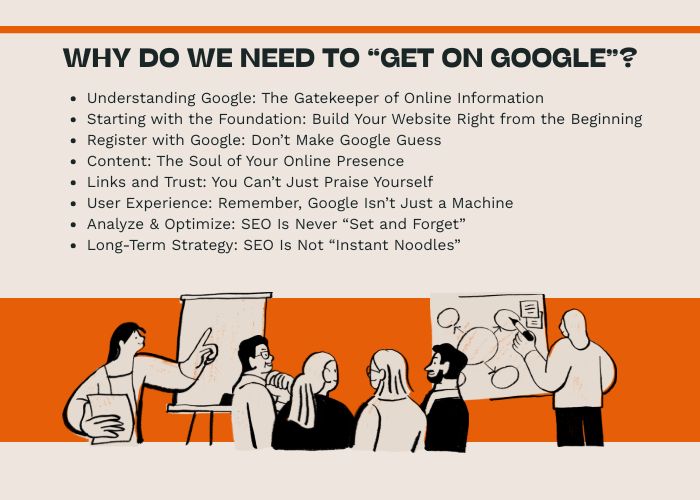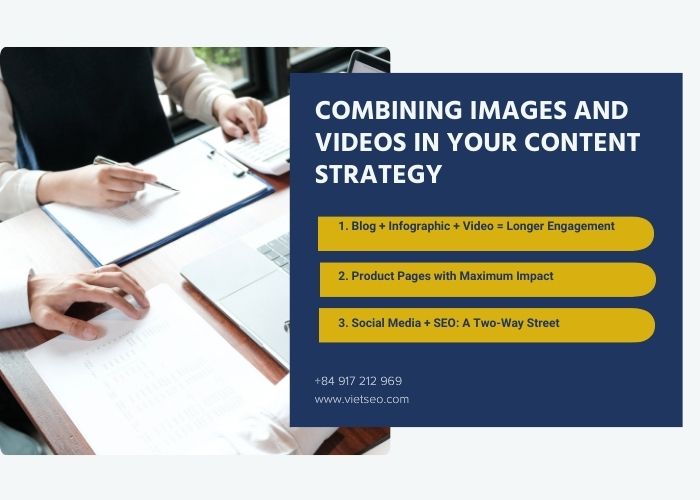The Journey to Getting Your Website to the Top of Google | Viet SEO
Why do we need to “get on Google”?
Think about the last time you needed an answer, a product, or a service. Chances are, the very first thing you did was open Google. That’s exactly what almost everyone does—whether it’s a student looking for information, a family searching for dinner options, or even a CEO comparing suppliers. The journey begins with a search.
Now imagine this: you own a beautiful store, fully stocked with quality products, excellent service, and a welcoming atmosphere. But instead of being on a busy main street, your store is tucked away in a small alley where no one passes by. No matter how good it is, very few people will ever find it. That’s exactly what happens to a website that isn’t on Google—or worse, one that shows up on page 10 or beyond.
In today’s digital world, appearing on Google is not a “nice-to-have” bonus. It’s the bare minimum to be seen, trusted, and considered by your audience. But showing up is only half the battle. What really matters is how you show up—whether your website appears for the right keywords, in front of the right people, and at the exact moment they’re ready to take action.
That’s the true meaning of “getting on Google.” And that’s the challenge every business must overcome if they want to compete and grow in the digital age.

Understanding Google: The Gatekeeper of Online Information
Google isn’t just a search engine - it’s the world’s most powerful gateway to information. Every second, billions of searches are made, and behind the scenes, Google decides which websites deserve to be seen first and which will remain invisible. But Google doesn’t rank websites randomly. Instead, it relies on a highly sophisticated system that evaluates hundreds of different factors before deciding what to show.
At its core, the process comes down to three main steps:
- Crawl – Googlebot, Google’s automated crawler, continuously scans the web, discovering new websites and checking existing ones for updates.
- Index – Once a page is found, it must meet certain quality standards to be stored in Google’s vast database. If a page isn’t indexed, it simply won’t appear in search results.
- Rank – When someone types a query, Google instantly compares thousands of possible pages, then ranks them according to relevance, credibility, and overall user experience.
What this means for businesses is simple: just putting your website online isn’t enough. You can’t expect Google to “find and reward” you by default. To earn visibility, your site must be optimized at every level—technically sound, filled with valuable content, fast-loading, and easy to use. Only then will Google see your site as worthy of ranking where your audience can actually find it.
Starting with the Foundation: Build Your Website Right from the Beginning
Think of your website as your digital home. Before you decorate it with content and SEO strategies, you need a solid foundation that Google can understand, trust, and reward. Without it, even the best content won’t help your site rank.
1. Choose an SEO-Friendly Platform
The platform you build on makes a big difference. Options like WordPress, Webflow, or Shopify are designed with SEO in mind. They typically offer built-in features such as:
- Customizable URLs – so you can create clean, keyword-friendly links.
- Meta title and description fields – to help Google and users understand your pages.
- Automatic sitemap.xml and robots.txt – to guide search engines in crawling your site.
Note: Custom-built websites can also perform very well in SEO, as long as developers pay attention to essentials like site speed, URL structure, and HTTPS security.
2. Set Up the Technical Basics
Before you launch, make sure your website is technically ready for Google to crawl and index. Key elements include:
- SSL (HTTPS) – A secure site not only builds trust with visitors but is also favored by Google.
- Responsive design – Your site must look and function smoothly on mobile, since most users search from their phones.
- Sitemap & robots.txt – These files tell Google which pages to crawl and which to skip.
- Clear URL structure – For example:
https://vietseo.com/en/basic-seo-techniques-to-help-your-website-rank-on-google/
instead of www.yourdomain.com/abc123?id=987.
3. Optimize Page Load Speed
Google has made it clear: speed is a ranking factor. A slow site not only hurts your SEO but also frustrates visitors, leading to higher bounce rates. Ideally, your site should load in under 3 seconds.
Quick wins to improve speed:
- Compress and convert images into modern formats like WebP.
- Invest in reliable, high-performance hosting.
- Avoid excessive or unnecessary plugins that slow your site down.
In short: building the right foundation saves you time, money, and headaches later. A website that’s technically strong from day one gives you a head start in the race to the top of Google.
Register with Google: Don’t Make Google Guess
Even if your website is beautifully built, Google won’t automatically know it exists. You need to take the first step and introduce your site to Google. That way, search engines can crawl, understand, and display your pages correctly.
1. Set Up Google Search Console
Google Search Console is a free but powerful tool every website owner should use. With it, you can:
- Check if your site is indexed – see which pages are showing up on Google.
- Submit your sitemap – tell Google exactly where to find your important pages.
- Monitor crawl errors – fix issues that prevent Google from reading your site properly.
- Track keyword performance – discover which search terms are bringing visitors to your site.
2. Submit Your Sitemap (sitemap.xml)
Your sitemap acts like a roadmap for Google. By submitting it through Search Console, you help Google understand your site’s structure and ensure important pages are crawled and indexed quickly.
3. Create a Proper Robots.txt File
The robots.txt file tells Googlebot which parts of your site it can or cannot crawl. For example, you might block admin or test pages, but you should always allow Google to access your main content.
Warning: Many beginners accidentally block their entire site by copying code without knowing what it does. Double-check before publishing your robots.txt!
Bottom line: don’t leave your site’s visibility to chance. By registering with Google and setting up these basics, you take control and ensure your website has the best shot at being discovered.
Content: The Soul of Your Online Presence
Technical SEO may help your website appear on Google, but it’s your content that convinces people to stay, engage, and trust your brand. More importantly, content is what builds long-term credibility with Google itself. Without it, even the most optimized site will struggle to compete.
1. Develop a Content Strategy
Random blog posts here and there won’t get you far. You need a clear, structured content plan that aligns with your audience’s needs and your business goals. A good strategy should focus on:
- Primary and secondary keywords – not just one or two, but a cluster of related topics.
- Real user problems – answer the questions your audience is actually searching for.
- Consistency – publish on a schedule so both users and Google know your site is active.
Example: If you’re in the travel industry, don’t stop at a broad article like “Top 10 Places to Visit in Da Lat.” Go deeper with content that solves practical problems, such as:
- “A Detailed 3-Day Da Lat Travel Budget (With Hidden Costs to Expect)”
- “Tips for Booking Cheap Flights to Da Lat Without Hidden Fees”
- “Homestays vs. Hotels in Da Lat: Which Is Better for Groups?”
This type of content shows both breadth and depth—helping you capture more search intent and build authority.
2. Follow the E-E-A-T Principle
Google has made it clear: quality matters. Content that demonstrates Experience, Expertise, Authoritativeness, and Trustworthiness (E-E-A-T) will always perform better than shallow, keyword-stuffed posts.
Here’s how to show E-E-A-T in your content:
- Include author names and bios so readers know who’s behind the content.
- Cite credible sources and link to reliable references.
- Write in-depth guides rather than thin, surface-level articles.
- Add real reviews, authentic images, and personal experiences to prove your content is genuine.
In short, think of content as the soul of your online presence. It’s what turns a website from a technical shell into a living, trustworthy resource that both people and Google want to return to.
Links and Trust: You Can’t Just Praise Yourself
Imagine meeting someone who constantly brags about how great they are—but no one else ever backs it up. Would you trust them? Probably not. Google feels the same way. It doesn’t just take your word for it that your website is valuable—it looks for signals from other trusted sources. That’s where links come in.
1. Build High-Quality Backlinks
Backlinks are like votes of confidence from other websites. When reputable sites link to yours, Google sees it as proof that your content is credible and worth ranking. But not all links are equal—quality matters far more than quantity.
Practical ways to earn strong backlinks:
- Guest posting – Write valuable articles for relevant blogs or online magazines in your industry.
- Industry directories – Submit your site to trusted, niche-specific directories (avoid spammy ones).
- Collaborations – Partner with influencers, experts, or other businesses to create content worth linking to.
Think of backlinks as relationships: you earn them by adding value, not by begging for favors.
2. Don’t Forget Internal Links
While backlinks from other sites are important, your internal links—the way you connect pages within your own website—also matter. Smart internal linking:
- Helps users easily navigate your site.
- Guides Google through your content, showing which pages are most important.
- Creates a strong “content network” that boosts overall site authority.
Example: If you publish a blog post about “SEO basics,” link it to your in-depth guide on “Technical SEO” and your article on “Content Strategy.” This way, you’re building a web of knowledge that benefits both readers and search engines.
In short, trust is earned. You can tell Google you’re great a thousand times, but until others—and your own content structure—back it up, you won’t win top rankings.
User Experience: Remember, Google Isn’t Just a Machine
Google’s algorithm may be powered by data, but ultimately it’s trying to serve people—not machines. That’s why it pays close attention to how real users interact with your website. If visitors land on your site and immediately leave, or if they struggle to find what they need, Google takes that as a negative signal.
Some of the key user behavior signals Google considers include:
- Bounce rate – Do people leave right after arriving?
- Time on page – Are visitors actually reading and engaging with your content?
- Interactions – Do users click links, watch videos, or complete forms on your site?
To create a positive user experience (UX) that keeps both visitors and Google happy, focus on:
- A clean, intuitive interface – Avoid clutter and make navigation effortless.
- Clear calls-to-action (CTAs) – Guide users toward the next step, whether that’s contacting you, making a purchase, or reading another article.
- Multi-device compatibility – Your website should look and perform seamlessly on desktops, tablets, and especially mobile phones.
In short: when users enjoy being on your site, Google notices—and rewards you with higher rankings.
Analyze & Optimize: SEO Is Never “Set and Forget”
Getting your website on Google is only the beginning. SEO isn’t a one-time task—it’s an ongoing process that requires constant attention and refinement. Search trends change, competitors adapt, and Google updates its algorithms regularly. To stay ahead, you need to treat SEO as a long-term game.
Key areas to focus on include:
- Track keyword rankings – Monitor where your pages stand in search results and identify opportunities to improve.
- Update old content – Refresh outdated articles, add new insights, and keep information relevant.
- Optimize speed and UX – Even small improvements in load time and user experience can make a big difference in rankings and conversions.
- Monitor user behavior – Use tools like Google Analytics to understand how visitors interact with your site and where they drop off.
In short: SEO success comes from consistency. The websites that win are those that keep learning, testing, and improving—not the ones that “set it and forget it.”
Long-Term Strategy: SEO Is Not “Instant Noodles”
If someone promises you “top rankings in just 7 days,” be careful. Real SEO doesn’t work like that. It’s not a quick hack or shortcut—it’s a long-term process of continuous optimization, testing, learning, and adapting. Businesses that treat SEO as a marathon, not a sprint, are the ones that see lasting results.
1. Combine SEO with Branding
A strong website isn’t built on technical SEO alone. To truly stand out, you need a brand identity that people recognize and trust. That means:
- A unique content style – so your articles don’t sound like everyone else’s.
- Consistent brand visuals – logos, colors, and design that reinforce your identity.
- Multichannel presence – from social media to press coverage to email marketing, your brand should appear wherever your audience spends time.
When SEO and branding work together, you don’t just get clicks—you build recognition and loyalty.
2. See SEO as Part of a Bigger Picture
SEO is powerful, but it’s only one piece of your digital marketing puzzle. To maximize growth, combine it with other strategies such as:
- Google Ads (paid search) – to capture quick wins while waiting for SEO to gain traction.
- Content marketing – to attract and educate your audience at every stage of the funnel.
- Social media marketing – to engage directly with customers and amplify your reach.
When integrated, these channels create a well-rounded digital strategy that supports both short-term gains and long-term growth.
In short: SEO isn’t a magic trick—it’s a commitment. The businesses that invest in it for the long run, while combining it with branding and other marketing channels, are the ones that win sustainably in the digital world.
Getting on Google Is Just the Beginning, Not the End
Appearing on Google isn’t the final destination—it’s the starting line. To get there, you need the right blend of technical expertise, high-quality content, smart strategy, and above all, patience. The process takes time, but the rewards are long-lasting: a strong digital presence that consistently attracts customers without depending solely on paid ads.
As Google itself shows time and again:
“It doesn’t reward the biggest spenders. It rewards those who deliver genuine value.”
Be that kind of website. Build with purpose, provide real value, and start your journey today.


